Ethiopia's money through the end
of the Haile Selassie Era
Ethiopia has used various forms of money through its history. Though it came late to using European style coins, it has used several non-standard items as mediums of exchange. This chapter gives you a quick rundown of some of Ethiopia's and Eritrea's monies ending with the coins we used while I lived in Asmara in 1967-1970.
Early coinage
|
In ancient times a kingdom centered around the modern northern Ethiopian city of Axum ruled all the southern Red Sea and issued many coins between the fourth and seventh century. The legends of earlier coins, like this one, was Greek. Later coins had Ge'ez, Axum's language. The "Axum" chapter of my book Ethiopia: Travels of a Youth includes several Axumite coin examples. |
 |
| Throughout its long history Ethiopia used many primitive monies that included salt bars and cowrie shells. | 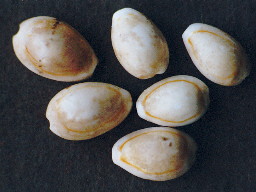 |
| From the early 1800s until very recently the coin of choice was the Maria Theresa Thaler shown here. Originally made in 1780, the coin has been minted by several countries ever since with the same date. In it's day it was used extensively throughout the Middle East as a trade coin of known value. Many used it as a source of silver, using it to make many small silver objects. This coin with three quarters of an ounce of silver is still used in some remote areas of the world and traded at its silver content value. | 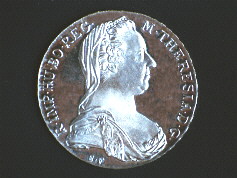 |
Menelik IIEthiopia's first modern national coins were those of the Emperor Menelik II in 1894. Menelik, wanting to establish the independence of Ethiopia, issued a series of silver coins designed and struck by the Paris Mint. They were 1 dollar (bir), 1/2 dollar (alad bir), 1/4 dollar (rub bir), 1/8 dollar (temum bir), and 1 girsh (1/20 bir). He also issued a copper 1/100 dollar (bir matonya). The silver coins all shared the same basic design. The obverse reads in Amharic, "Menelik II, King of Kings of Ethiopia." The date is below the bust. The reverse reads, "Conquering Lion of the tribe of Judah." The denomination is written on the bottom along with the A mint mark of Paris and the cornucopia and torch privy marks. |
 |
The first reverse design with a staff and flag in the lion's left paw was soon changed to a more robust lion with staff in its right paw, a more fitting posture. A new Addis Ababa mint issued some of the minor coins. These have no mint mark. Only the lower denominations were ever used much. The well-known Maria Theresa Thaler remained the coin of choice of the great majority. Ethiopian calendarEthiopia's modern coins are dated by the Ethiopian calendar, which is seven to eight years before the Gregorian calendar that most of the rest of the Western world uses. The year number changes from year to year on our September 11. For example, 1994 of the Ethiopian era (EE) is our September to December, 2001, and January to September, 2002. The last date on Menelik's coins is 1895EE (1903) even though coins were made as late as 1928 with that same date. |
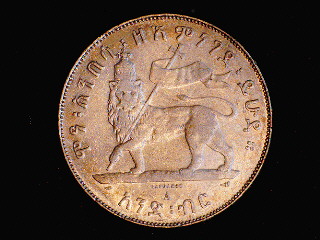 |
Creative changesThe early Ethiopian minters showed their creativeness by taking a die originally intended for a silver 1/8 bir and using it to make a copper 1/32 bir. They ground the 1/8th bir out of the dies and made new copper coins from the defaced dies until new dies were available to reflect the new value. |
 |
Italian EritreaWhile Menelik was introducing his coins, Italy issued a series of coins for it's new colony of Eritrea between 1890 and 1896. The coins, all silver, included a 50 centesimi and a 1, 2, and 5 lire. Trying into the area currencies, each coin actually had three separate values. The 5 Italian lire, or tallero, equaled 1 Ethiopian bir and 1 Arabian rial, all stated nicely in the respective language and alphabet on the coin. The obverse of the coins reads "Umberto King of Italy" followed by the date. The reverse reads "Eritrean Colony" on the top followed by the denomination in the three languages. The 50 centesimi was minted in Milan and the others in Rome Only the smaller coins saw minor circulation. The Maria Theresa held its own in a conservative economy against the tallero. A new tallero in 1918 tried to mimic the Maria Theresa but fared no better. |
 |
Haile SelassieWith his coronation in 1930 (1923EE) Haile Selassie issued 1, 5, 10, 25, and 50 Matonya (matonya=1/100th) coins all of the same design. The obverse reads in Amharic, "Haile Selassie I, King of Kings of Ethiopia." The date (unchanging 1923EE) is behind the head and the denomination below the bust, both in Amharic. The reverse reads, "Conquering lion of the tribe of Judah." The denomination is written as a number on the bottom. This series had no dollar-sized coin. England's King's Norton mint in Birmingham made the early one Matonya coins. The Addis Ababa mint made all the rest. The Maria Theresa Thaler remained the coin of choice in day-to-day commerce. |
 |
Italian occupationWhile Italy occupied Ethiopia between 1936 and 1941 the coins of Italy were current in their new Italian East Africa. Italy added "E IMP," "and Emperor (of Italian East Africa)" to the inscription around Victor Emmanuel on all their coins. The Maria Theresa Thaler (many made in Italy!) was the only coin with much currency. |
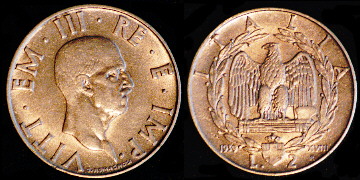 |
After occupationAfter England took Ethiopia from Italy and gave it back to Haile Selassie in 1941, England tried, with little success, to establish the shilling-cent system of their East African Currency Board (EACB) by circulating both EACB coins and currency. Neither really worked in Ethiopia, where they quickly issued their own currency. But the EACB currency was Eritrea's currency during the British Mandate period from 1946 through 1952. |
 |
Haile Selassie's coinsEthiopian suspicion of British intentions and desire for national identity lead to a new series of coins designed in Philadelphia by John Sinnoch (obv) and Gilroy Roberts (rev). The obverse shows the bust of Haile Selassie and the date 1936EE (1944); the reverse has the Lion of Judah and the denomination 1, 5, 10, 25, or 50 santim (cent) in Amharic. The latter was silver while the others were bronze. Philadelphia, Birmingham, and the Royal mint have all minted this series. Ethiopia used these coins into the late 1970s, until three years after the beginning of Socialist Ethiopia when the socialist regime issued their own coins. These 1936EE dated coins are the only ones we used while I was in Eritrea. The original 25 cent coin was round like the 50 cent piece and close to the same size. Enterprising people quickly discovered they could silver plate the former and pass it for the latter. Few could read the denomination. After a bit more than 400,000 were made, they were withdrawn from circulation and hand scalloped. Later ones were minted with a special milling collar to form the scallops shown on the coin here. |
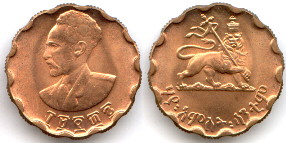 |
Much of the text of this page was originally the chapter Ethiopia's Money in my book Ethiopia: Travels of a Youth.